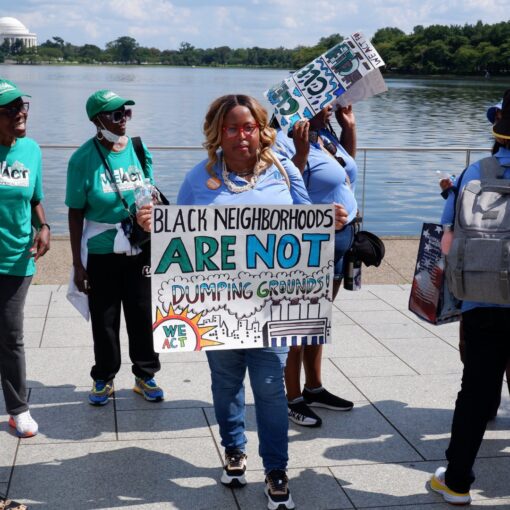In January, the first case to enforce the requirements of New York’s Climate Leadership and Community Protection Act (CLCPA) was filed in the state Supreme Court. Enacted in 2019, the CLCPA sets ambitious greenhouse gas (GHG) reduction goals for the State of New York, while incorporating principles of environmental justice. Under the CLCPA, state agencies cannot make decisions that would interfere with the state’s ability to meet its GHG reduction targets without providing a detailed justification (Section 7(2)), and cannot make decisions that would disproportionately burden disadvantaged communities at all (Section 7(3)).
The case filed in January alleges that the New York Public Service Commission (NYPSC) failed to meet these requirements when it approved the sale of a power plant for use in cryptocurrency mining (the “Fortistar decision”).
The Plaintiffs in the case—Clean Air Coalition of Western New York and Sierra Club—argue that the new owners will significantly increase the operation of the power plant, leading to higher GHG emissions and burdening nearby communities that have been designated as disadvantaged by the state’s draft criteria. The NYPSC did not consider these potential impacts, however. In its decision, the NYPSC determined that Sections 7(2) and 7(3) of the CLCPA were inapplicable because impacts on emissions and disadvantaged communities were “beyond the scope of the limited review undertaken” in the proceeding. The NYPSC also stated that environmental impacts and CLCPA compliance could be considered during the proceedings to obtain any permits needed to operate the plant. Ultimately, the Plaintiffs argue that this determination was erroneous, and that the NYPSC should have considered both questions before allowing the sale to proceed.
In light of this case’s potential to break new ground on the judicial interpretation of the CLCPA, it’s worth examining how the state’s administrative agencies have interpreted or applied the statute since it became effective in 2020. Thus far, the vast majority of agency decisions interpreting the CLCPA have come from the NYPSC, which has broad regulatory authority over utility service and rates, meaning its activities frequently implicate the issues raised by Sections 7(2) and 7(3).
Applicability of Sections 7(2) and (3) of the CLCPA to Agency Decisions
Sections 7(2) and 7(3) of the CLCPA require all state agencies to evaluate the potential impact on GHG emissions and disadvantaged communities “in considering and issuing permits, licenses, and other administrative approvals and decisions.” In the absence of case law defining the applicability of the CLCPA to different types of decisions, an agency must make its own determination about when the Act’s requirements apply to its decision-making.
Outside of the Fortistar decision, the NYPSC has analyzed whether the procedural requirements of Sections 7(2) and 7(3) apply to a handful of other types of actions. For example, in a 2021 rate case, the NYPSC described the applicability of the CLCPA as “the most contested issue in these proceedings.” The NYPSC noted that there was “some ambiguity” in the language of the CLCPA, but determined that the requirements of Sections 7(2) and 7(3) apply to rate cases because they fall under the umbrella of “administrative approvals.” The NYPSC explained that “absent Commission approval” of the utility’s rate plan, specific projects “would likely not be pursued by the utility,” suggesting that incorporating the CLCPA into the agency’s decision-making could be consequential in guiding the utility’s planning toward more climate- and environmental justice-conscious actions.
The Fortistar decision, by contrast, arose when the parties to the transaction sought a declaration from the NYPSC that it did not need to conduct any additional review under the Public Service Law before the transfer of the facility could proceed. New York’s Public Service Law requires the NYPSC to review and approve the ownership transfer of a power plant before it can take place. However, when the NYPSC determines, as it did in this instance, that the transaction will not harm the interests of captive utility customers or create potential for the exercise of horizontal or vertical market power, it may allow the transfer to go forward without this review.
Interpretation of Sections 7(2) and 7(3)
Where an agency determines that the CLCPA applies to a particular decision, that decision must comply with the requirements of Sections 7(2) and 7(3). As discussed above, these Sections require state agencies to consider whether a decision is inconsistent or interferes with the attainment of state GHG emissions limits or disproportionately burdens disadvantaged communities. While these provisions have proven consequential in a number of agency actions so far, the level of agency engagement with the questions raised by these Sections varies.
DEC has applied Section 7 of the CLCPA to deny Clean Air Act Title V permits on three occasions. On October 27, 2021, it issued a notice of denial on Astoria Gas Turbine Power, LLC (Astoria)’s application for a Title V permit for the construction of a new natural gas-fired peaker plant in Astoria, Queens. The same day, DEC issued a similar notice of denial on the application of Danskammer Energy (Danskammer) for a Title V permit for construction of a new natural gas-fired power plant in Orange County. In June 2022, DEC also denied Greenidge Generation LLC (Greenidge)’s application to renew its existing Title V permit for its natural gas-fired power plant in Yates County.
In all three denial decisions, DEC determined that issuing or renewing the Title V permit “would be inconsistent with or would interfere with the attainment of the Statewide greenhouse gas (GHG) emission limits” established by the CLCPA, and that the applicant had failed to justify the operation of the facility, demonstrate a reliability need for the project, or identify adequate GHG mitigation measures. In each instance, the agency provided an in-depth analysis of the past, present, and projected emissions associated with the facility and addressed the applicant’s claims that operation of the plant would be consistent with the CLCPA and that the operation of the facility was justified or necessary.
So far, these denials have been effective in limiting the emissions generated by these facilities. Although Danskammer appealed the denial of its permit application in the New York Supreme Court, the appeal was rejected in June 2022. Danskammer Energy v. DEC, 173 N.Y.S. 3d 134 (Sup. Ct., Orange Cty, 2022). And while Astoria also initially sought to appeal the denial of its application, the company sold the land it had planned to use for the plant to a wind developer in January 2023, effectively ending its appeal.
Outside of DEC, agency engagement with Sections 7(2) and 7(3) has varied greatly. In some cases, agency decisions have provided a lengthy analysis of the impacts of a proposed action on the state’s GHG emissions goals or nearby disadvantaged communities. In the rate order discussed earlier, the NYPSC carefully weighed its statutory duty under the Public Service Law to assure “safe and adequate” utility service “at just and reasonable rates” with its responsibilities under the CLCPA, finding that it could not conduct its CLCPA review “in a vacuum” and had to “balance reliability, public safety, and reasonable rates interests with emission reductions and clean energy objectives.” However, in other instances, agency decisions have included only a brief statement of compliance, such as a finding that their decision “is consistent with the CLCPA.”
Other invocations of the CLCPA
In addition to applying and interpreting Sections 7(2) and 7(3) of the CLCPA, agencies have relied on the CLCPA in a number of other decisions. Most notably, the NYPSC has issued several orders incorporating the requirements and policies of the CLCPA into its program design. For example, in its order extending NYSERDA’s distributed solar incentive, the NYPSC noted that its decision serves in part to fulfill the CLCPA’s requirement that the NYPSC establish programs to procure six gigawatts of photovoltaic solar generation. Similarly, in its order continuing certain exemptions to standby rates, the NYPSC chose to end its previous exemption for energy sources that were at odds with the CLCPA’s goals.
The NYPSC has also incorporated the CLCPA into its orders related to transmission planning policy and implementation. In 2021, the NYPSC determined that some of the CLCPA’s requirements created a Public Policy Transmission Need for additional transmission facilities, allowing the NYISO to solicit proposed solutions from developers, who could then recover their costs under the NYISO’s Open Access Transmission Tariff. The NYPSC has also repeatedly discussed the CLCPA as a significant motivator in its decisions related to local transmission and distribution planning. Finally, in setting the cost allocation for this transmission development, the NYPSC relied on the CLCPA as evidence of the statewide nature of the benefits of emissions reductions, justifying a statewide allocation of costs.
Conclusion
It remains to be seen how a court will analyze or apply the CLCPA. However, the existing landscape of administrative decisions relying on the CLCPA provides some indication of the interpretive questions and challenges that the statute may generate.
Andrea Nishi is the Climate Justice Fellow at the Sabin Center for Climate Change Law.






